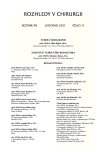Lung Transplantation
Authors:
R. Lischke; J. Šimonek; J. Pozniak; J. Schützner; P. Pafko
Authors‘ workplace:
III. chirurgická klinika 1. LF UK a FN Motol, přednosta: doc. MUDr. Robert Lischke, Ph. D.
Published in:
Rozhl. Chir., 2011, roč. 90, č. 11, s. 612-620.
Category:
Monothematic special - Original
Overview
Lung transplantation is an effective life-saving therapy for the treatment of a variety of end-stage lung diseases. However, the application of lung transplantation is hindered by multiple factors such as the shortage of organ donors, early graft failure, infection, and chronic graft dysfunction.
A novel strategy for donor lung preservation - ex-vivo lung perfusion (EVLP) – that keeps the organ at physiological protective conditions, has shown great promise to increase lung utilization by reassessing, treating, and repairing injured donor lungs prior to transplantation.
Infections are a major cause of early morbidity and mortality after lung transplantation. Because of the potential association of infections such as respiratory viral infections and gram-negative bacterial infections with bronchiolitis obliterans syndrome, prompt attention to these pathogens is critical. Despite marked improvements in early survival, long-term outcome after lung transplantation is still threatened by bronchiolitis obliterans syndrome. The program of lung transplantation in Czech Republic was started in University Hospital Motol in Prague in 1997. Nowadays in Czech Republic is performed about 20 transplants every year with results comparable to other advanced centers. Until September 2011, 175 transplants were carried out in Czech Republic.
Key words:
lung transplant – indication – technique – complications
Sources
1. Hardy, J. D. The first lung transplant in man (1963) and the first heart transplant in man (1964). Transplant. Proc., 1999, Feb-Mar; 31 (1-2): 25–29.
2. Borel, J. F. History of the discovery of cyclosporin and of its early pharmacological development. Wien Klin. Wochenschr., 2002, Jun 28; 114 (12): 433–437.
3. Cooper, J. D. The history of surgical procedures for emphysema. Ann. Thorac. Surg., 1997, Feb; 63(2): 312–319.
4. Steen, S., Liao, Q., Wierup, P. N., Bolys, R., Pierre, L., Sjoberg, T. Transplantation of lungs from non-heart-beating donors after functional assessment ex vivo. Ann. Thorac. Surg., 2003, Jul; 76 (1): 244–252; discussion 252.
5. Steen, S., Ingemansson, R., Eriksson, L., Pierre, L., Algotsson, L., Wierup, P., Liao, Q., Eyjolfsson, A., Gustafsson, R., Sjöberg, T. First human transplantation of anonacceptable donor lung after reconditioning ex vivo. Ann. Thorac. Surg., 2007, Jun; 83 (6): 2191–2194.
6. Orens, J. P. International Guidelines for the Selection of Lung Transplant Candidates: 2006 Update-A Consensus Report From the Pulmonary Scientific Council of the International Society for Heart and Lung Transplantation. J. Heart Lung Transplant., 2006, Jul; 25 (7): 745–755.
7. Celli, B. R., Cote, C. G., Marin, J. M., Casanova, C., Montes de Oca, M., Mendez, R. A., Pinto Plata, V., Cabral, H. J. The body-mass index, airflow obstruction, dyspnea, and exercise capacity index in chronic obstructive pulmonary disease. N. Engl. J. Med., 2004, Mar 4; 350 (10): 1005–1012.
8. Aigner, C., Wisser, W., Taghavi, S., et al. Institutional experience with extracorporeal membrane oxygenation in lung transplantation. Eur. J. Cardiothorac. Surg., 2007, Mar; 31 (3): 468–473.
9. Lau, C. L., Patterson, G. A., Palmer, S. M. Critical care aspects of lung transplantation. J. Intensive Care Med., 2004, Mar-Apr; 19 (2): 83–104.
10. Snell, G. I., Westall, G. P. Immunosuppression for lung transplantation: evidence to date. Drugs, 2007; 67 (11): 1531–1539.
11. Groetzner, J., Kur, F., Spelsberg, F., et al. Munich Lung Transplant Group. Airway anastomosis complications in de novo lung transplantation with sirolimus-based immunosuppression. J. Heart Lung Transplant., 2004, May; 23 (5): 632–638.
12. Hernandez, R. L., Gil, P. U., Gallo, C. G., et al. Rapamycin in lung transplantation. Transplant. Proc., 2005, Nov; 37 (9): 3999–4000.
13. Oto, T., Levvey, B. J., Snell, G. I. Potential refinements of the International Society for Heart and Lung Transplantation primary graft dysfunction grading system. J. Heart Lung Transplant., 2007, May; 26 (5): 431–436.
14. Lischke, R., Sarahrudi, K., Neuhauser, P., et al. Bronchial anastomoses after lung transplantation: results with single running suture technique. Chirurg, 2001, Sep; 72 (9): 1048–1053.
15. Glanville, A. R. The role of bronchoscopic surveillance monitoring in the care of lung transplant recipients. Semin. Respir. Crit. Care Med., 2006, Oct; 27 (5): 480–491.
16. Estenne, M., Hertz, M. Bronchiolitis obliterans after human lung transplantation. Am. J. Respir. Crit. Care Med., 2002; 166: 440–444.
17. Aigner, C., Jaksch, P., Taghavi, S., et al. Pulmonary retransplantation: is it worth the effort? A long-term analysis of 46 cases. J. Heart Lung Transplant., 2008, Jan; 27 (1): 60–65.
Labels
Surgery Orthopaedics Trauma surgeryArticle was published in
Perspectives in Surgery

2011 Issue 11
Most read in this issue
- Acute Mediastinitis
- Lung Transplantation
- Esophageal Perforation
- Are There Any News in the Management of Spontaneous Pneumothorax?
